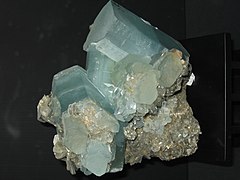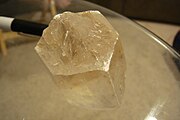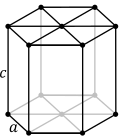
An example of the hexagonal crystals, beryl |
|

Hexagonal Hanksite crystal |

Hexagonal lattice cell |
In crystallography, the hexagonal crystal system is one of the 7 crystal systems, the hexagonal lattice system is one of the 7 lattice systems, and the hexagonal crystal family is one of the 6 crystal families. They are closely related and often confused with each other, but they are not the same. The hexagonal lattice system consists of just one Bravais lattice type: the hexagonal one. The hexagonal crystal system consists of the 7 point groups such that all their space groups have the hexagonal lattice as underlying lattice. The hexagonal crystal family consists of the 12 point groups such that at least one of their space groups has the hexagonal lattice as underlying lattice, and is the union of the hexagonal crystal system and the trigonal crystal system.[1]
In some cases, it is useful or instructive to redraw a hexagonal structure with orthohexagonal axes, wherein the b axis is redrawn at 90° to the a and c axes.
Graphite is an example of a crystal that crystallizes in the hexagonal crystal system.
Contents |
Hexagonal lattice system
The hexagonal lattice system is one of the seven lattice systems, consisting of the hexagonal Bravais lattice. It is associated with 45 space groups whose underlying lattice has point group of order 24. It is often confused with the smaller hexagonal crystal system, which consists of the 27 space groups such that all space groups with the same point group are in the hexagonal lattice system, or with the larger hexagonal crystal family, consisting of the 52 space groups in either the hexagonal or rhombohedral lattice systems.
Hexagonal crystal system
The point groups (crystal classes) in this crystal system are listed below, followed by their representations in Hermann-Mauguin or international notation and Schoenflies notation, and mineral examples, if they exist.[1][2]
| # | Point group | Example | Space groups | ||||
|---|---|---|---|---|---|---|---|
| Class | Intl | Schoenflies | Orbifold | Coxeter | |||
| 168-173 | Hexagonal pyramidal | 6 | C6 | 66 | [6]+ | nepheline, cancrinite | P6, P61, P65, P62, P64, P63 |
| 174 | Trigonal dipyramidal | 6 | C3h | 3* | [2,3+] | Laurelite | P6 |
| 175-176 | Hexagonal dipyramidal | 6/m | C6h | 6* | [2,6+] | apatite, vanadinite | P6/m, P63/m |
| 177-182 | Hexagonal trapezohedral | 622 | D6 | 226 | [2,6]+ | kalsilite and high quartz | P622, P6122, P6522, P6222, P6422, P6322 |
| 183-186 | Dihexagonal pyramidal | 6mm | C6v | *66 | [6] | greenockite, wurtzite | P6mm, P6cc, P63cm, P63mc |
| 187-190 | Ditrigonal dipyramidal | 6m2 | D3h | *223 | [2,3] | benitoite | P6m2, P6c2, P62m, P62c |
| 191-194 | Dihexagonal dipyramidal | 6/mmm | D6h | *226 | [2,6] | beryl | P6/mmm, P6/mcc, P63/mcm, P63/mmc |
Hexagonal crystal family
The hexagonal crystal family consists of the 12 point groups such that at least one of their space groups has the hexagonal lattice as underlying lattice, and is the union of the hexagonal crystal system and the trigonal crystal system. There are 50 space groups associated with it, which are exactly those whose Bravais lattice is either hexagonal or rhombohedral.
See also
References
- ^ a b Hurlbut, Cornelius S.; Klein, Cornelis, 1985, Manual of Mineralogy, 20th ed., pp. 78 – 89, ISBN 0-471-80580-7
- ^ http://webmineral.com/crystall.shtml Crystallography and Minerals Arranged by Crystal Form, Webmineral
|
|||||
This information originally retrieved from http://en.wikipedia.org/wiki/Hexagonal_crystal_system
on Wednesday 3rd August 2011 6:20 pm EDT
Now edited and maintained by ManufacturingET.org
